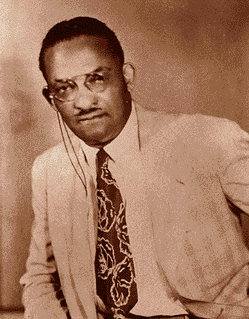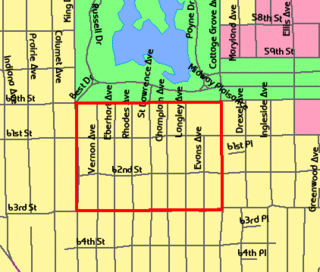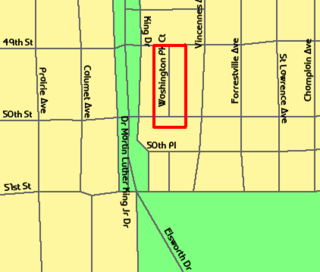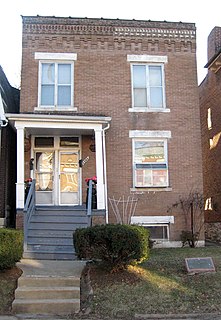Charles Hamilton Houston was a prominent African-American lawyer, Dean of Howard University Law School, and NAACP first special counsel, or Litigation Director. A graduate of Amherst College and Harvard Law School, Houston played a significant role in dismantling Jim Crow laws, especially attacking segregation in schools and racial housing covenants. He earned the title "The Man Who Killed Jim Crow".

Ossian Sweet was an African-American physician in Detroit, Michigan. He is known for being charged with murder in 1925 after he and his friends used armed self-defense against a hostile white mob protesting after Sweet moved into their neighborhood. Stones were thrown at his house, breaking windows. Shots were fired, and one white man was killed and another wounded. Sweet, his wife, and nine associates at the house were all arrested and charged with murder.

Blockbusting was a business practice in which real estate agents and building developers convinced white residents in a particular area to sell their property at below-market prices. This was achieved by fearmongering the homeowners, telling them that racial minorities would soon be moving into their neighborhoods. The blockbusters would then sell those same houses at inflated prices to black families seeking upward mobility. Blockbusting became prominent after post-World War II bans on explicitly segregationist real estate practices. By the 1980s it had mostly disappeared in the United States after changes to the law and real estate market.
A covenant, in its most general sense and historical sense, is a solemn promise to engage in or refrain from a specified action. Under historical English common law, a covenant was distinguished from an ordinary contract by the presence of a seal. Because the presence of a seal indicated an unusual solemnity in the promises made in a covenant, the common law would enforce a covenant even in the absence of consideration. In United States contract law, an implied covenant of good faith is presumed.

Noble and Wolf v Alley [1951] S.C.R. 64 is a famous Supreme Court of Canada decision where the Court struck down a restrictive covenant that restricted ownership of a section of land to "persons of the white or Caucasian race".
Hansberry v. Lee, 311 U.S. 32 (1940), is a famous case now usually known in civil procedure for teaching that res judicata may not bind a subsequent litigant who had no opportunity to be represented in the earlier civil action. The facts of the case dealt with a racially restrictive covenant that barred African Americans from purchasing or leasing land in the Washington Park Subdivision of Chicago's Woodlawn neighborhood. The covenant had been upheld in a prior class action lawsuit, which had included Lee, along with all the other neighborhood landowners, as members of the class. The plaintiff in the present case argued that Carl Augustus Hansberry could not contest the covenant because it had already been deemed valid by the courts in the prior lawsuit. The defendant's case was successfully argued by civil rights attorney Earl B. Dickerson.

The Washington Park Subdivision is the name of the historic 3-city block by 4-city block subdivision in the northwest corner of the Woodlawn community area, on the South Side of Chicago in Illinois that stands in the place of the original Washington Park Race Track. The area evolved as a redevelopment of the land previously occupied by the racetrack. It was originally an exclusively white neighborhood that included residential housing, amusement parks, and beer gardens.

The Washington Park Court District is a Grand Boulevard community area neighborhood on the South Side of Chicago, Illinois. It was designated a Chicago Landmark on October 2, 1991. Despite its name, it is not located within either the Washington Park community area or the Washington Park park, but is one block north of both. The district was named for the Park.

Loren Miller was an American journalist, civil rights activist, attorney, and judge. Miller was appointed to the Los Angeles County Superior Court by governor Edmund G. "Pat" Brown in 1964 and served until his death in 1967. Miller was a specialist in housing discrimination, whose involvement in the early stages of the Civil Rights Movement earned him a reputation as a tenacious fighter for equal housing opportunities for minorities. Miller argued some of the most historic civil rights cases ever heard before the Supreme Court of the United States. He was chief counsel before the court in the 1948 decision that led to the outlawing of racial restrictive covenants, Shelley v. Kraemer.

The Shelley House is a historic house at 4600 Labadie Avenue in St. Louis, Missouri. Built in 1906, this duplex was the focus of the 1948 United States Supreme Court case Shelley v. Kraemer, which ruled that judicial enforcement by state courts of racially restrictive covenants violated the Constitution. The house was designated a National Historic Landmark on December 14, 1990.

The Ossian H. Sweet House is a privately owned house located at 2905 Garland Street in Detroit, Michigan. The house was designed by Maurice Herman Finkel, and in 1925 it was bought by its second owner, physician Ossian Sweet, an African American. Soon after he moved in, the house was the site of a confrontation when a white mob of about 1,000 gathered in protest of the Sweet family moving into the formerly all-white neighborhood. Rocks thrown by the mob broke windows, and someone in the house fired out at the mob, killing one man and wounding another. Sweet and ten other persons from the house were arrested for murder.
Shelley v. Kraemer, 334 U.S. 1 (1948), is a landmark United States Supreme Court case that struck down racially restrictive housing covenants.

Earl B. Dickerson (1891–1986) was a prominent African American attorney, community activist and business executive who successfully argued before the U. S. Supreme Court in Hansberry v. Lee.
Re Drummond Wren [1945] O.R. 778 is a decision by the Ontario High Court, presided by Justice Mackay, regarding the validity of a racially motivated restrictive covenant. The Workers' Educational Association purchased the lot in East York. The covenant prohibited the land to be sold to "Jews, or persons of objectionable nationality". Drummond Wren brought forward an action to have the restrictive covenant declared invalid. Wren was the general secretary of the Workers' Educational Association. He was represented by John Cartwright and Irving Himel. J. M. Bennett appeared as legal counsel for the Canadian Jewish Congress, assisted by Bora Laskin, Jacob Finkelman, and Charles Dubin.

Black Detroiters are black or African American residents of Detroit. According to the U.S. Census Bureau, Black or African Americans living in Detroit accounted for 79.1% of the total population, or approximately 532,425 people as of 2017 estimates. According to the 2000 U.S. Census, of all U.S. cities with 100,000 or more people, Detroit had the second-highest percentage of Black people.
Corrigan v. Buckley, 271 U.S. 323 (1926), was a US Supreme Court case in 1926 that ruled that the racially-restrictive covenant of multiple residents on S Street NW, between 18th Street and New Hampshire Avenue, in Washington, DC, was a legally-binding document that made the selling of a house to a black family a void contract. This ruling set the precedent upholding racially restrictive covenants in Washington; soon after this ruling, racially restrictive covenants flourished around the nation. Subsequently, in Shelley v. Kraemer (1948) the court reconsidered such covenants and found that racially restrictive covenants are unenforceable.
Hurd v. Hodge, 334 U.S. 24 (1948), was a companion case to Shelley v. Kraemer, in which the Court held that the Fourteenth Amendment prohibits a federal court from enforcing restrictive covenants that would prohibit a person from owning or occupying property based on race or color. Hurd v. Hodge also involved racially restrictive covenants on houses in the Bloomingdale neighborhood of Washington, D.C.

Ghettos in the United States are typically urban neighborhoods perceived as being high in crime and poverty. The origins of these areas are specific to the United States and its laws, which created ghettos through both legislation and private efforts to segregate America for political, economic, social, and ideological reasons: de jure and de facto segregation. De facto segregation continues today in ways such as residential segregation and school segregation because of contemporary behavior and the historical legacy of de jure segregation.
Rock Creek Hills is a mostly residential neighborhood of Kensington, Maryland.













